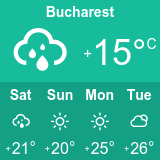Location: Europe, Romania

The Danube Delta (Romanian: Delta Dunării) is one of the greatest deltas in the world!
Declared a biosphere reserve in 1990, it was also designated a natural and cultural heritage by UNESCO.
The Danube Delta is one of the world’s most extensive wetlands (2681 sq km).
In this exotic delta, which stretches between the fluvial branches of the Chilia, Sulina and St George, more than 1200 species of plants and trees, 300 species of birds and 100 species of fish have been identified. The Danube Delta is a veritable Noah’s Arch.


Here, everything teems with life: the air hums to the wing-beat of birds (pelicans, swans, cormorants, egrets, spoonbills, widgeons, white-tailed eagles); beneath the water’s surface glint fish (sturgeon, trout, perch, pike, carp); among the reeds swarm all kind of animals. In the Delta there also live turtles, snakes, vipers, otters, foxes, boar, and enots.




Almost 50 per cent of the surface area of the Danube Delta lies temporarily under water, 45 per cent is permanently covered with water and just 5 percent can be said to be genuinely dry land and never floods. Luxuriant and wild vegetation, from the beginning of the world, covers these expanses of water and earth. The Delta is in fact a labyrinth of branches, channels, swamps, lakes, sand banks and endless passages of reeds.

You loose ourselves in groves of white willows or in mixed woods, formed of black poplars, trembling poplars, oaks, bushy ash, elms, and wild apple and pear trees. Here is the domain of creeping plants, such as lianas and wild vines, which inter-penetrate everywhere.

The immense surfaces of rushes, bulrushes and reeds make up and unforgettable décor. The waters stretch into the distance covered in white and yellow lily pads, broken here and there by floating islands of vegetation.


One of the most interesting attractions in the Danube’s Delta. „Letea” forest has been attested as the most northern „tropical” forest, and this strange case of existence is directly related to migratory birds, which is believed they might have exchanged tropical plant seeds between different climatic territories. A broad variety of flora and fauna exists in this place, turning it into a hot-target for worldwide explorers and researchers.
It is located between the Sulina and Chilia branches of Danube in the Danube Delta and it covers an area of aproximatively 2,825 ha (6,980 acres). This forest was the initial foundation of the Danube Delta Biosphere Reserve which has been declared a World Heritage Site and internationally recognized as a Biosphere Reserve under UNESCO’s Man and the Biosphere Programme in 1992.

It has a subtropical aspect due to the presence of the tropical creeper named Periploca graeca. This is a Mediterranean plant which finds its most northern refuge in Danube Delta. Along with this type of liana, other climbing plants are woven on the branches of the trees: the wild vine, the hop plant, the ivy, etc. Letea Forest is formed mainly from White Poplar, Black Poplar, Elm tree, English Oak, Silver Lime, Narrow-leafed Ash, Common Alder, etc. Along with these ones above it is completed by a rich scale of sub-shrub species. It is also home for a rich fauna like Red-footed Falcon, White-tailed Eagle, Roller, Hoopoe, Vipera ursinii, Danube Delta horse, etc. – approximatively 1600 entomofauna species identified until today.




The traditional fishing villages of the Danube Delta seem remnants of an ancestral world. The people from hereabouts make their living by fishing. The traditional fish dishes of these parts are highly prized. If you find yourself here, you will be able to dine on spitted fish, fish broth, and pickled fish with garlic juice, fried fishcakes. You are also sure to be tempted by a wine from the Niculitel Vineyard; the most appreciated varieties are the Aligote, the Muscat – Ottonel and the Merlot.









ein wunderbarer Ort, eine Welt mit Charme